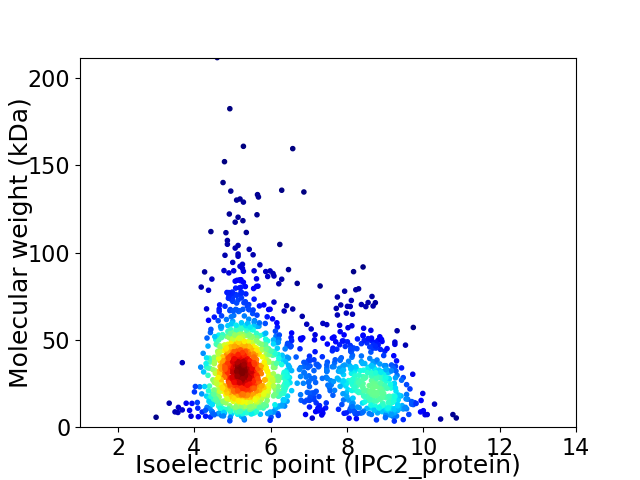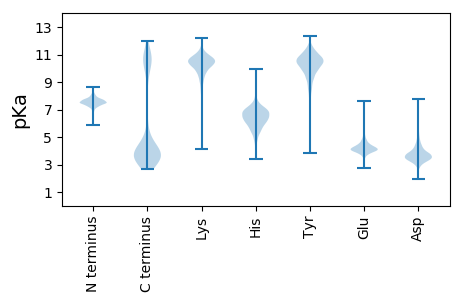
Peptoniphilus sp. ING2-D1G
Taxonomy: cellular organisms; Bacteria; Terrabacteria group; Firmicutes; Tissierellia; Tissierellales; Peptoniphilaceae; Peptoniphilus; unclassified Peptoniphilus
Average proteome isoelectric point is 6.22
Get precalculated fractions of proteins

Virtual 2D-PAGE plot for 1528 proteins (isoelectric point calculated using IPC2_protein)
Get csv file with sequences according to given criteria:
* You can choose from 21 different methods for calculating isoelectric point
Summary statistics related to proteome-wise predictions



Protein with the lowest isoelectric point:
>tr|A0A090I1X4|A0A090I1X4_9FIRM HAD-superfamily hydrolase subfamily IB OS=Peptoniphilus sp. ING2-D1G OX=1912856 GN=ING2D1G_0431 PE=4 SV=1
MM1 pKa = 7.88DD2 pKa = 5.02FDD4 pKa = 5.55EE5 pKa = 5.83SLQQYY10 pKa = 8.28TYY12 pKa = 10.72AYY14 pKa = 9.05EE15 pKa = 4.3DD16 pKa = 5.28LIFVWDD22 pKa = 4.4EE23 pKa = 3.81LPKK26 pKa = 10.9EE27 pKa = 4.12NFHH30 pKa = 7.25EE31 pKa = 4.32IVEE34 pKa = 4.33VLADD38 pKa = 3.78SYY40 pKa = 11.75HH41 pKa = 6.5EE42 pKa = 4.37NFDD45 pKa = 4.46GILDD49 pKa = 4.8FILPNLRR56 pKa = 11.84EE57 pKa = 3.91IYY59 pKa = 10.87GDD61 pKa = 3.39VTRR64 pKa = 11.84EE65 pKa = 3.82DD66 pKa = 3.79VEE68 pKa = 4.38NKK70 pKa = 9.35IGKK73 pKa = 9.03PIINPEE79 pKa = 4.12NEE81 pKa = 4.03TVTYY85 pKa = 10.1CDD87 pKa = 3.1QSFDD91 pKa = 3.11SWHH94 pKa = 6.31IFTFEE99 pKa = 3.76FSNNNFEE106 pKa = 4.38DD107 pKa = 3.71LNYY110 pKa = 10.5FSVDD114 pKa = 3.05GG115 pKa = 4.3
MM1 pKa = 7.88DD2 pKa = 5.02FDD4 pKa = 5.55EE5 pKa = 5.83SLQQYY10 pKa = 8.28TYY12 pKa = 10.72AYY14 pKa = 9.05EE15 pKa = 4.3DD16 pKa = 5.28LIFVWDD22 pKa = 4.4EE23 pKa = 3.81LPKK26 pKa = 10.9EE27 pKa = 4.12NFHH30 pKa = 7.25EE31 pKa = 4.32IVEE34 pKa = 4.33VLADD38 pKa = 3.78SYY40 pKa = 11.75HH41 pKa = 6.5EE42 pKa = 4.37NFDD45 pKa = 4.46GILDD49 pKa = 4.8FILPNLRR56 pKa = 11.84EE57 pKa = 3.91IYY59 pKa = 10.87GDD61 pKa = 3.39VTRR64 pKa = 11.84EE65 pKa = 3.82DD66 pKa = 3.79VEE68 pKa = 4.38NKK70 pKa = 9.35IGKK73 pKa = 9.03PIINPEE79 pKa = 4.12NEE81 pKa = 4.03TVTYY85 pKa = 10.1CDD87 pKa = 3.1QSFDD91 pKa = 3.11SWHH94 pKa = 6.31IFTFEE99 pKa = 3.76FSNNNFEE106 pKa = 4.38DD107 pKa = 3.71LNYY110 pKa = 10.5FSVDD114 pKa = 3.05GG115 pKa = 4.3
Molecular weight: 13.73 kDa
Isoelectric point according different methods:
Protein with the highest isoelectric point:
>tr|A0A090JMI5|A0A090JMI5_9FIRM Branched-chain amino acid transport system carrier protein OS=Peptoniphilus sp. ING2-D1G OX=1912856 GN=brnQ PE=3 SV=1
MM1 pKa = 7.48SKK3 pKa = 10.6NLIKK7 pKa = 10.82NLSRR11 pKa = 11.84KK12 pKa = 9.14IKK14 pKa = 9.46LAKK17 pKa = 9.55FARR20 pKa = 11.84KK21 pKa = 9.54FSISTVKK28 pKa = 10.4LGKK31 pKa = 9.78IAFAVSRR38 pKa = 11.84IQKK41 pKa = 9.53RR42 pKa = 11.84NKK44 pKa = 10.11SKK46 pKa = 11.15
MM1 pKa = 7.48SKK3 pKa = 10.6NLIKK7 pKa = 10.82NLSRR11 pKa = 11.84KK12 pKa = 9.14IKK14 pKa = 9.46LAKK17 pKa = 9.55FARR20 pKa = 11.84KK21 pKa = 9.54FSISTVKK28 pKa = 10.4LGKK31 pKa = 9.78IAFAVSRR38 pKa = 11.84IQKK41 pKa = 9.53RR42 pKa = 11.84NKK44 pKa = 10.11SKK46 pKa = 11.15
Molecular weight: 5.28 kDa
Isoelectric point according different methods:
Peptides (in silico digests for buttom-up proteomics)
Below you can find in silico digests of the whole proteome with Trypsin, Chymotrypsin, Trypsin+LysC, LysN, ArgC proteases suitable for different mass spec machines.| Try ESI |
 |
|---|
| ChTry ESI |
 |
|---|
| ArgC ESI |
 |
|---|
| LysN ESI |
 |
|---|
| TryLysC ESI |
 |
|---|
| Try MALDI |
 |
|---|
| ChTry MALDI |
 |
|---|
| ArgC MALDI |
 |
|---|
| LysN MALDI |
 |
|---|
| TryLysC MALDI |
 |
|---|
| Try LTQ |
 |
|---|
| ChTry LTQ |
 |
|---|
| ArgC LTQ |
 |
|---|
| LysN LTQ |
 |
|---|
| TryLysC LTQ |
 |
|---|
| Try MSlow |
 |
|---|
| ChTry MSlow |
 |
|---|
| ArgC MSlow |
 |
|---|
| LysN MSlow |
 |
|---|
| TryLysC MSlow |
 |
|---|
| Try MShigh |
 |
|---|
| ChTry MShigh |
 |
|---|
| ArgC MShigh |
 |
|---|
| LysN MShigh |
 |
|---|
| TryLysC MShigh |
 |
|---|
General Statistics
Number of major isoforms |
Number of additional isoforms |
Number of all proteins |
Number of amino acids |
Min. Seq. Length |
Max. Seq. Length |
Avg. Seq. Length |
Avg. Mol. Weight |
|---|---|---|---|---|---|---|---|
0 |
474248 |
30 |
1929 |
310.4 |
35.04 |
Amino acid frequency
Ala |
Cys |
Asp |
Glu |
Phe |
Gly |
His |
Ile |
Lys |
Leu |
|---|---|---|---|---|---|---|---|---|---|
6.0 ± 0.075 | 0.853 ± 0.023 |
6.064 ± 0.055 | 7.944 ± 0.076 |
4.542 ± 0.051 | 6.465 ± 0.069 |
1.309 ± 0.021 | 9.528 ± 0.066 |
8.804 ± 0.076 | 9.073 ± 0.069 |
Met |
Asn |
Gln |
Pro |
Arg |
Ser |
Thr |
Val |
Trp |
Tyr |
|---|---|---|---|---|---|---|---|---|---|
2.621 ± 0.029 | 5.733 ± 0.054 |
2.869 ± 0.035 | 2.288 ± 0.028 |
3.649 ± 0.04 | 6.282 ± 0.043 |
4.816 ± 0.044 | 6.427 ± 0.054 |
0.539 ± 0.018 | 4.196 ± 0.046 |
Most of the basic statistics you can see at this page can be downloaded from this CSV file
Proteome-pI is available under Creative Commons Attribution-NoDerivs license, for more details see here
| Reference: Kozlowski LP. Proteome-pI 2.0: Proteome Isoelectric Point Database Update. Nucleic Acids Res. 2021, doi: 10.1093/nar/gkab944 | Contact: Lukasz P. Kozlowski |
